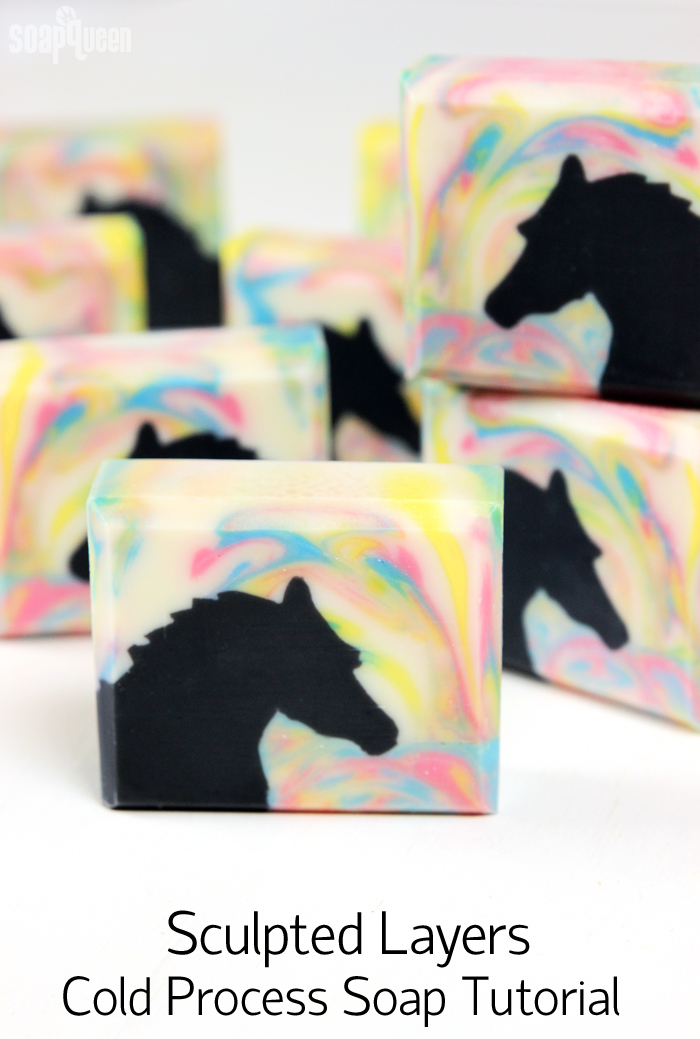
I’m constantly blown away by the talent and innovation in the soapmaking community. There are so many amazing ways to manipulate soap to create various effects. One of the most impressive techniques that I’ve seen in the past few years is the Sculpted Layers technique made popular by Claudia Carpenter of Om Nom Soap. When I first stumbled on Claudia’s Winter Wonderland Soap made with this technique, my first reaction was “HOW!?” I had never seen any soap quite like it before.
Claudia graciously shared her technique, which involves creating sturdy shapes that slide across the length of the mold to “sculpt” firm soap, leaving behind various shapes. The next layer is then poured on top, allowed to harden, and sculpted with the accompanying piece. Amy Warden of Great Cakes Soapworks hosted a Sculpted Layers challenge in June. The entries were amazing. It’s a bit of a tricky technique to describe, so I recommend watching this video by Love Is Sweet Shop, this video by Kapia Mera Soap Co, or this video by Earth’s Raw Beauty to see it in action.
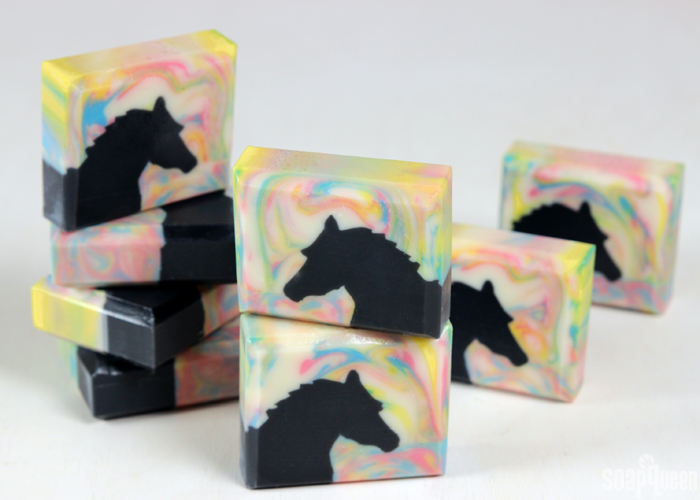
If you watched the videos above, you already know this technique is quite advanced. Between making the sculpting pieces, prepping the ingredients, and waiting the correct amount of time to sculpt each layer, it’s a long process. My team and I (thanks Caitlin!) came up with a fairly simple horse design which only required two sculpting pieces and three layers. The horse head template is already sized to fit inside the Silicone Liner for 5 lb Wood Mold; just download and print! To help the horse silhouette really pop, I chose a deep black color against swirls of white, pink, blue and yellow soap. Apple Sage Fragrance Oil gives the bars a sweet scent, and works great for this project because it gives you plenty of time to swirl.
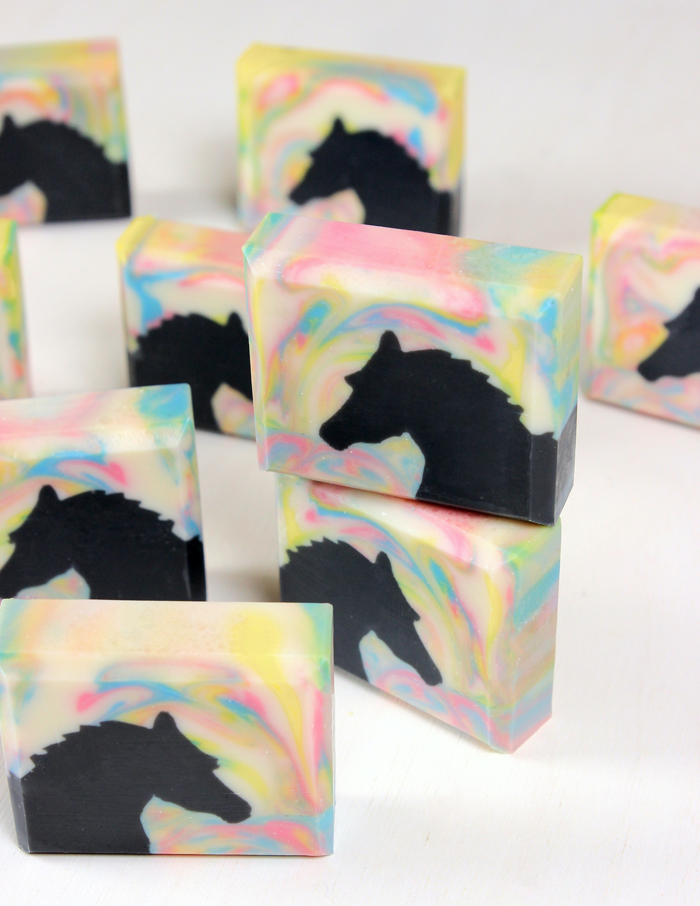
The only downside to this technique (in my opinion) is it does result in a lot of “extra” soap. The technique requires you to scrape away soap to leave behind a shape. This requires you to make a lot of soap that you ultimately remove from the mold. If you want to save the soap that is scraped away, I recommend having an extra mold nearby to plop the soap into. My bars made with the leftover soap weren’t the prettiest (rainbow swirls and black soap mushed together is an interesting look) but they were still wonderful bars of soap!
What You’ll Need:
5 Pound Mold with Sliding Bottom
Silicone Liner for 5 lb Wood Mold
Horse Silhouette Template
First Layer:
40 oz. Basic Quick Mix
5.7 oz. Sodium Hydroxide Lye
13.2 oz. Distilled Water
2 oz. Apple Sage Fragrance Oil
Titanium Dioxide
Buttercup Mica
Magenta Mica
Blue Slushy Mica
Second Layer:
40 oz. Basic Quick Mix
5.7 oz. Sodium Hydroxide Lye
13.2 oz. Distilled Water
2 oz. Apple Sage Fragrance Oil
Black Oxide
Third Layer:
20 oz. Basic Quick Mix
2.8 oz. Sodium Hydroxide Lye
6.6 oz. Distilled Water
1 oz. Apple Sage Fragrance Oil
Titanium Dioxide
Buttercup Mica
Magenta Mica
Blue Slushy Mica

Click here (or the button above) to add everything you need for this project to your Bramble Berry shopping cart!
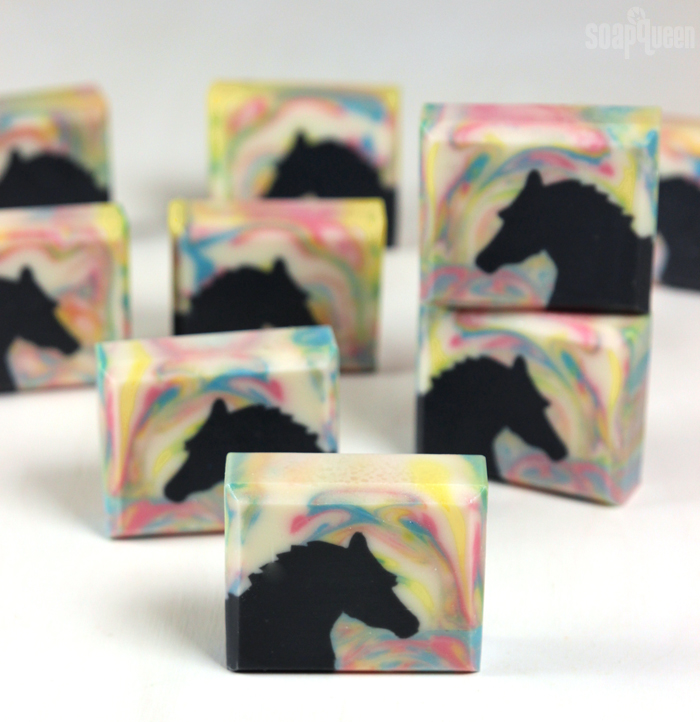
SCULPTING “TOOL” PREP: First, you need to prep the tools to “sculpt” the soap. Arguably, this might be the trickiest part of the whole process. Some designs require multiple sculpting pieces that are incredibly intricate and complicated; check out all the pieces Claudia made for her soap! So awesome. I tried to keep mine rather simple and created three pieces. To make the pieces you need cardboard, clear plastic packing tape and three printed horse images.
The first piece I made was the entire horse image, which was placed on one end of the mold. I used this as a guide for pouring the soap into the mold to the appropriate heights (shown below). To make this piece, I cut the horse image and taped it to cardboard. Then, I cut the cardboard to include a lip on top to keep it in place.
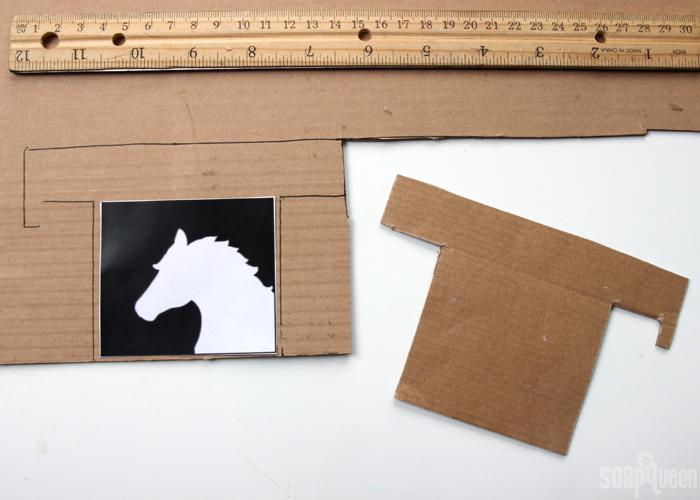
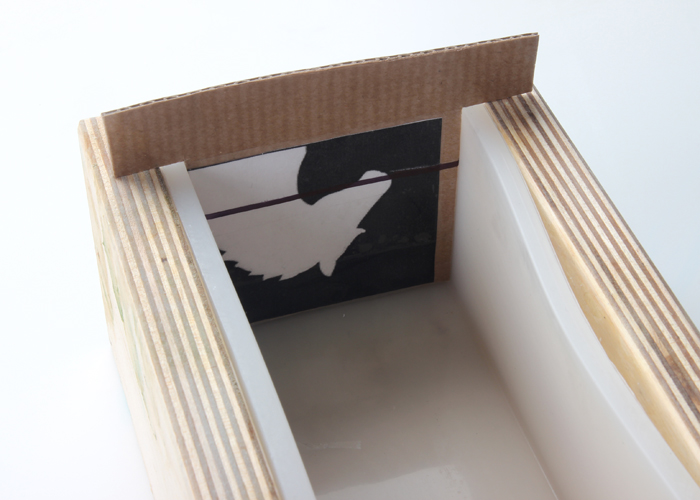
The other two pieces were made in a similar way. Print the horse image on a piece of paper, cut the cardboard to fit inside the width of the inside of the mold, and cut. Then, wrap the whole thing in clear plastic tape. This prevents it from becoming soggy when it comes in contact with the soap batter. On the top lip, I included a small piece that hangs over the side of the mold (shown on the right in the image below). The way, when you slide the piece down the length of the mold, it will stay in the same place with each pass. This is an important part of this technique; each pass needs to go in the exact same place, or it will muddle the shape.
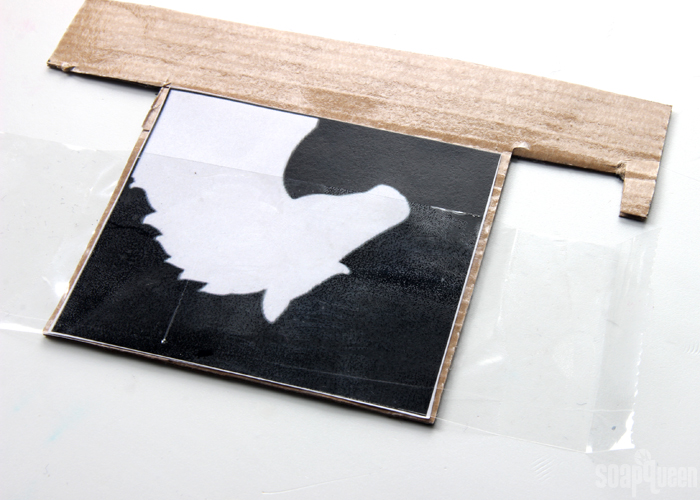
For the first piece, cut around the top of the horse head, ending where the nose begins to curve. This will be used to create the first layer.
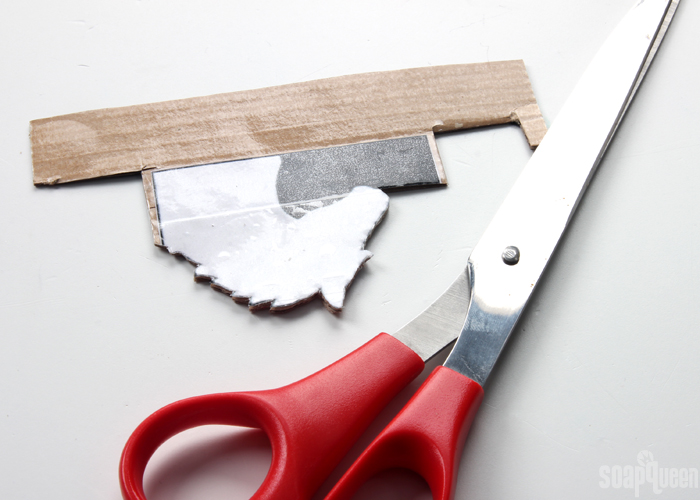
The second piece needs to “complete” the first. Cut out the entire horse head, including the nose, leaving behind the spot under the nose. You can see what the two pieces should look like below. Set your pieces aside to prep the remaining ingredients.
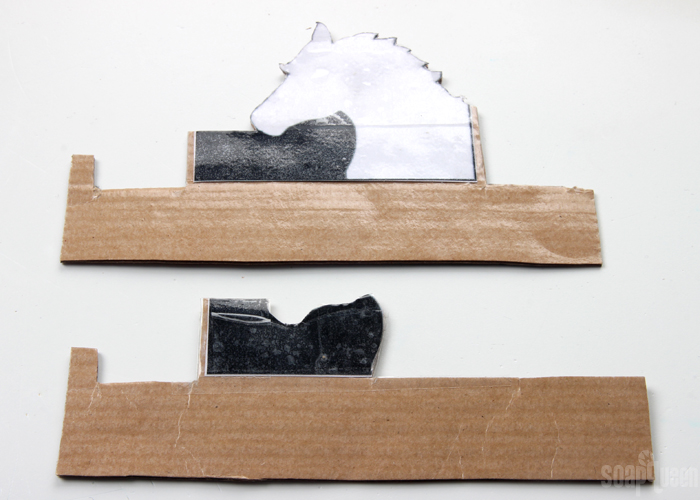 If you’ve never made cold process soap before, stop here! I highly recommend checking out our FREE four part SoapQueen.tv series on Cold Process Soapmaking, especially the episode on lye safety. And if you’d rather do some reading, Bramble Berry carries a wide range of books on the topic, including my newest book, Pure Soapmaking. You can also checkout the digital downloads for that instant gratification factor.
If you’ve never made cold process soap before, stop here! I highly recommend checking out our FREE four part SoapQueen.tv series on Cold Process Soapmaking, especially the episode on lye safety. And if you’d rather do some reading, Bramble Berry carries a wide range of books on the topic, including my newest book, Pure Soapmaking. You can also checkout the digital downloads for that instant gratification factor.
SAFETY FIRST: Suit up for safe handling practices! That means goggles, gloves and long sleeves. Make sure kids, pets, and other distractions and tripping hazards are out of the house or don’t have access to your soaping space. Always soap in a well-ventilated area.
*NOTE: This recipe involves three different batches of soap. You can either prep all three batches at the same time, or one after the other after making the step before. Personally, I recommend prepping all three steps at the same time. This means prepping three bowls of oil and three containers of lye. All the colorants can be prepped before, and the fragrance oil can be weighed in the same glass container before pouring to save on dishes. Prepping everything at once ensures you don’t let the layer of soap below set too long and become too thick, which makes it impossible to smoothly drag your shape through the mold. This means the lye for the second and third layer will be on the cooler side, but I found that to work fine. If you prefer prepping your ingredients in a different order, feel free.
COLOR PREP: To ensure that the Titanium Dioxide blends smoothly into the soap batter, we recommend micronizing it before dispersing it in oil. Please note this is an optional tip but it does help with the titanium dioxide clumping in the soap. =) To micronize colorant, simply use a coffee grinder to blend the colorant to break up any clumps of color and prevent streaks of white from showing in the final soap. We like to use a coffee grinder that has a removable, stainless steel mixing area for easy cleaning. Disperse 2 teaspoon of the colorant into 2 tablespoons of sunflower or sweet almond oil (or any other liquid oil). Then in a separate containers, disperse 1 teaspoon Buttercup Mica, 1 teaspoon Magenta Mica and 1 teaspoon Slushy Blue Mica into 1 tablespoon of oil. Finally, disperse 1/2 teaspoon Black Oxide into 1/2 tablespoon oil. Use a mini mixer to help get rid of any clumps.
FRAGRANCE OIL PREP: In a glass, fragrance oil safe container, measure 2 ounces of Apple Sage Fragrance Oil. Set aside. This is the fragrance for the first layer. Once you pour the fragrance into the soap, keep the cup around to measure the fragrance oil for the following batches.
ONE: Slowly and carefully add the lye to the water for all three batches, and gently stir until the lye has fully dissolved and the liquid is clear. Set aside to cool. You will have three containers of lye, with the amounts below. Once cooled, add sodium lactate to the lye water for a bar of soap that releases faster from the mold.
- Batch One Lye Solution: 13.2 oz. Distilled Water + 5.7 oz. Sodium Hydroxide Lye + 2.5 tsp. Sodium Lactate (optional)
- Batch Two Lye Solution: 13.2 oz. Distilled Water + 5.7 oz. Sodium Hydroxide Lye + 2.5 tsp. Sodium Lactate (optional)
- Batch Three Lye Solution: 6.6 oz. Distilled Water + 2.8 oz. Sodium Hydroxide Lye + 1 tsp. Sodium Lactate (optional)
TWO: Fully melt the entire bag of Basic Quick Mix until there is no cloudiness. Give it a good shake to mix all the oils, and measure out 40 ounces into one soaping bowl, 40 ounces into a second and 20 ounces into a third. Set aside the bowls of oil for batch two and three. Once the lye water and the oils for batch one have cooled to 130 degrees or below (and are ideally within 10 degrees of each other), add the batch one lye water to the oils and stick blend until thin trace.
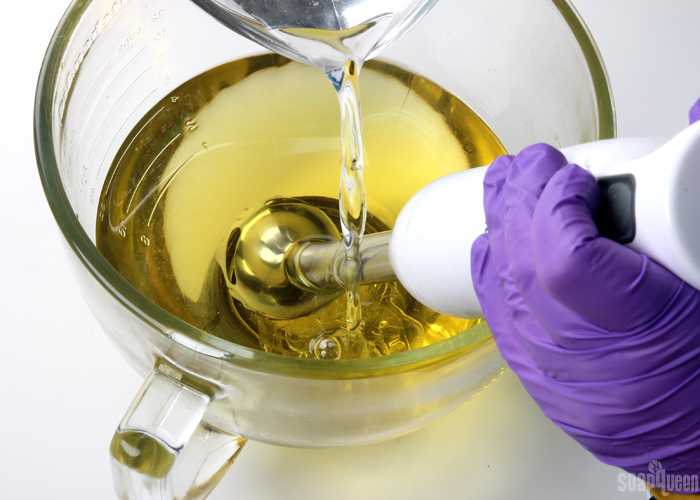 THREE: Once you have a thin trace, add 1 Tbs. dispersed titanium dioxide into the entire batch. Split off three containers of 200 mL. Add the dispersed colorants in the following amounts below, and use a whisk to fully incorporate the colorants.
THREE: Once you have a thin trace, add 1 Tbs. dispersed titanium dioxide into the entire batch. Split off three containers of 200 mL. Add the dispersed colorants in the following amounts below, and use a whisk to fully incorporate the colorants.
- Container A (200 mL): 1 tsp. dispersed Buttercup Mica
- Container B (200 mL): 1/2 tsp. dispersed Slushy Blue Mica
- Container C (200 mL): 1/2 tsp. Magenta Mica
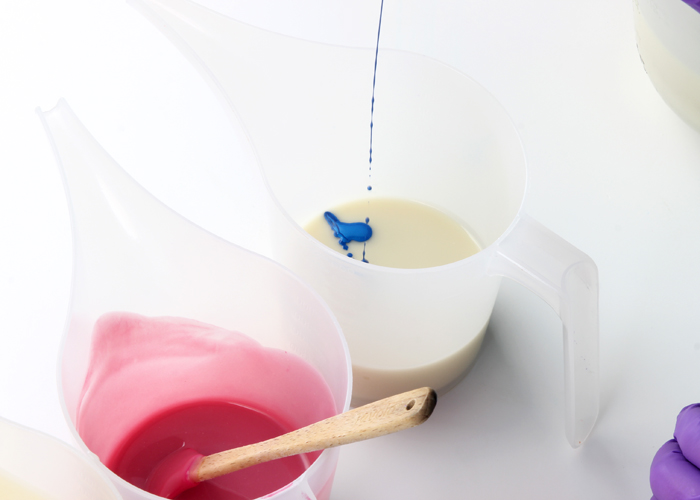 FOUR: Add the measured Apple Sage Fragrance Oil into each container proportionally, it’s okay to eyeball it. Use a whisk to mix in the fragrance oil. If the batter is still extremely thin, give the white soap a short burst or two with the stick blender to thicken slightly. The soap should be a thin-medium trace.
FOUR: Add the measured Apple Sage Fragrance Oil into each container proportionally, it’s okay to eyeball it. Use a whisk to mix in the fragrance oil. If the batter is still extremely thin, give the white soap a short burst or two with the stick blender to thicken slightly. The soap should be a thin-medium trace.
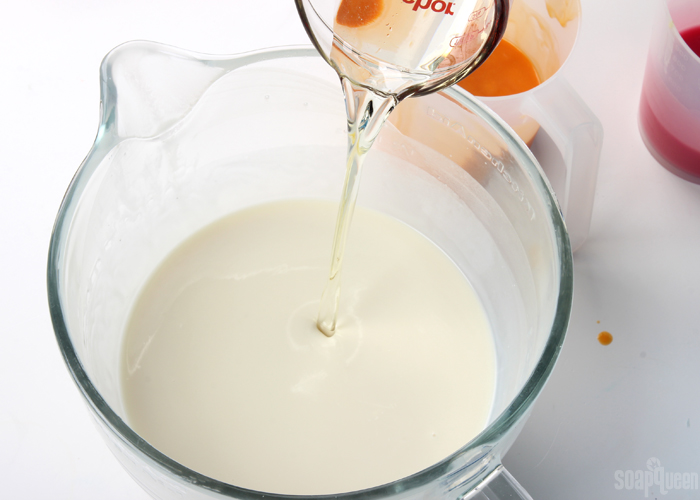 FIVE: Create an In-The-Pot Swirl by pouring the pink, yellow and blue soap into various areas of the white bowl of soap. Pour from various heights above the mold. This helps the colors break through the white, and reach the bottom of the bowl as well as the top. Once the colors have all been poured, use a chopstick or dowel to swirl the soap in a circular motion three to four times.
FIVE: Create an In-The-Pot Swirl by pouring the pink, yellow and blue soap into various areas of the white bowl of soap. Pour from various heights above the mold. This helps the colors break through the white, and reach the bottom of the bowl as well as the top. Once the colors have all been poured, use a chopstick or dowel to swirl the soap in a circular motion three to four times.
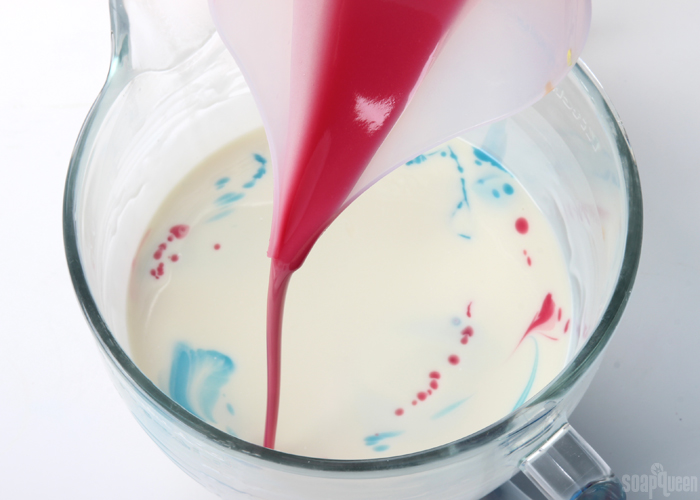
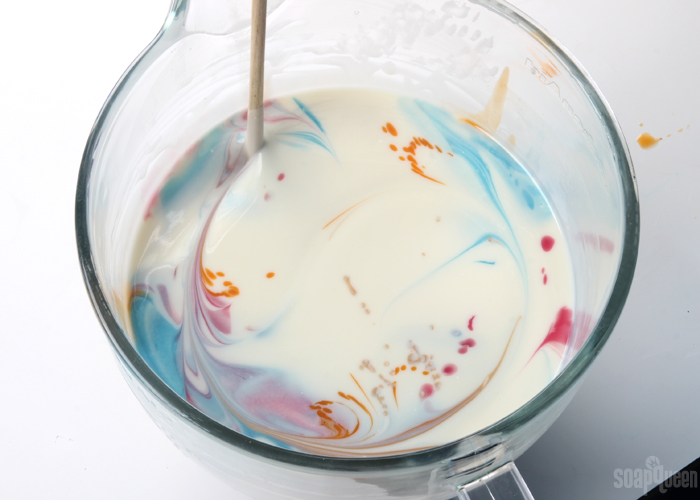 SIX: Pour the soap into the mold. The soap will not fill up the mold all the way; fill up to the middle-ish of the horse nose. Give the mold a tap on the counter to help release air bubbles.
SIX: Pour the soap into the mold. The soap will not fill up the mold all the way; fill up to the middle-ish of the horse nose. Give the mold a tap on the counter to help release air bubbles.
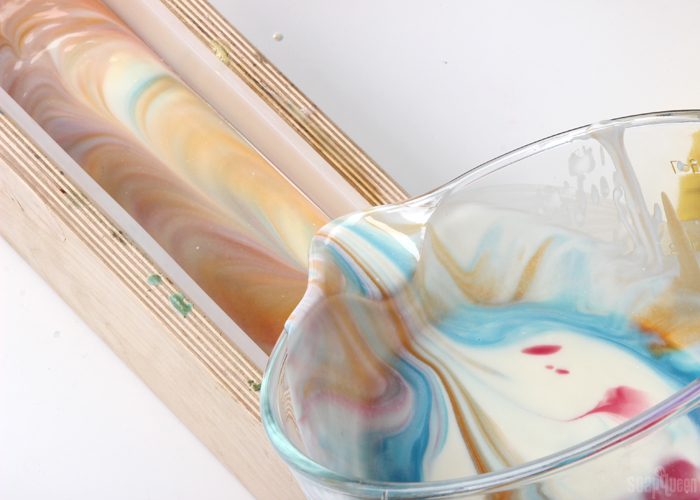 SEVEN: Now, it’s time to wait for the soap to firm and harden. The soap should be firm enough to hold its shape, but thin enough for the soap to be scraped out smoothly. It’s a little hard to know when that “perfect” texture has been achieved. I tested every 3-5 minutes or so by scraping a small amount of the very top of the soap with a spoon. It is better to start scraping out the extra soap sooner rather than later. If the soap is not thick enough to hold any shape, let it harden for a few more minutes. But, if the soap is too thick, there is no going back. For this recipe, I found waiting about 8 minutes was the perfect amount of time for the first layer. Your soap may require more or less time, so keep an eye on it.
SEVEN: Now, it’s time to wait for the soap to firm and harden. The soap should be firm enough to hold its shape, but thin enough for the soap to be scraped out smoothly. It’s a little hard to know when that “perfect” texture has been achieved. I tested every 3-5 minutes or so by scraping a small amount of the very top of the soap with a spoon. It is better to start scraping out the extra soap sooner rather than later. If the soap is not thick enough to hold any shape, let it harden for a few more minutes. But, if the soap is too thick, there is no going back. For this recipe, I found waiting about 8 minutes was the perfect amount of time for the first layer. Your soap may require more or less time, so keep an eye on it.
Once the soap is an appropriate texture, insert the cardboard shape with the horse nose into one edge of the soap, and begin pulling it through the mold. Place the extra soap into a separate mold if you’d like to save it. The first few passes with the cardboard shaper will be a little awkward and messy, but that’s okay! This process will begin to form the top of the horse’s outline including the mane, ears, and top of the nose.
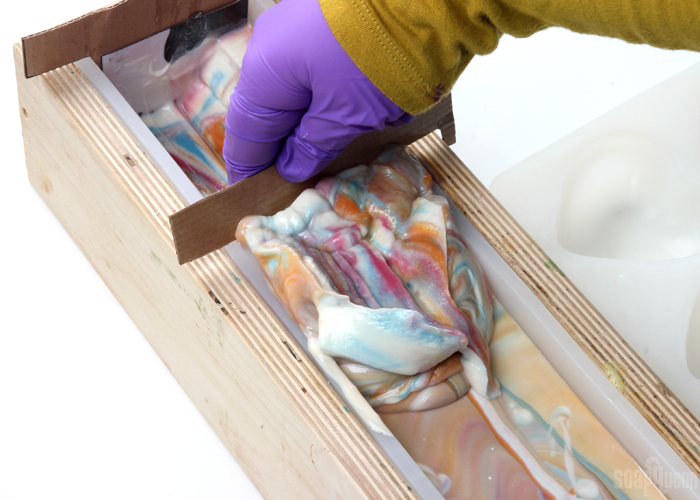
Continue sliding the shaper through the mold. I recommend sliding it in both directions; it will help pull away every little bit of soap for the cleanest image. As you can see below, the shape of the horse is starting to come together! Once you pull the scraper away and it’s no longer pulling soap out, you know it’s done. Allow this layer to sit and harden for 10-15 minutes. The bottom layer should be firm enough to support a thin layer of soap on top without it squishing the small details of the mane, and general shape of the nose.
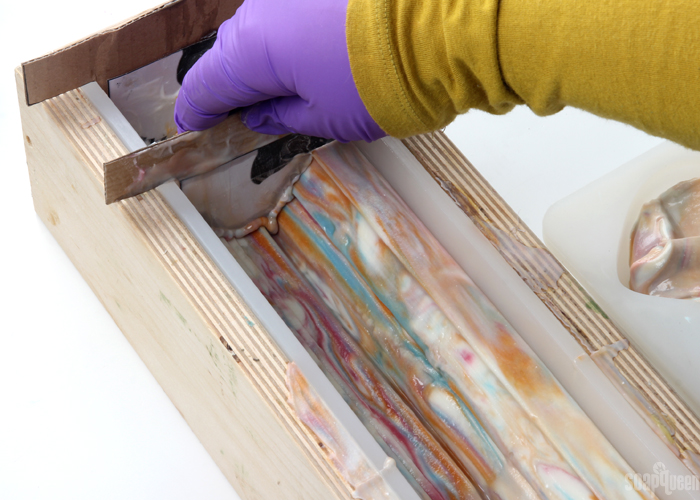
BATCH #2
FRAGRANCE PREP: Measure 2 ounces of the Apple Sage Fragrance Oil into a glass, fragrance oil safe container, set aside.
EIGHT: Once the first layer is firm, it’s time to make the second layer. Heat up the bowl of oils for batch two if necessary to 120-130 ° F. Most likely, the lye water will be a little on the cool side, but that’s okay. Add the batch two lye water to the oils and stick blend until thin trace.
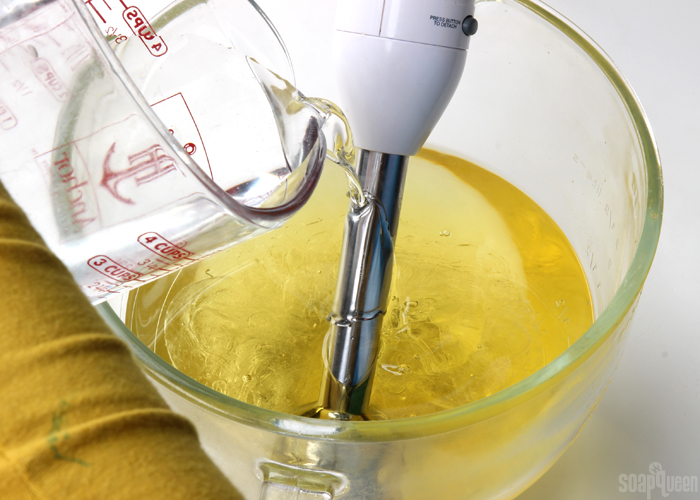 NINE: Add 1 teaspoon dispersed Black Oxide, and the measured Apple Sage Fragrance Oil. Use a whisk to fully mix in the colorant and fragrance oil.
NINE: Add 1 teaspoon dispersed Black Oxide, and the measured Apple Sage Fragrance Oil. Use a whisk to fully mix in the colorant and fragrance oil.
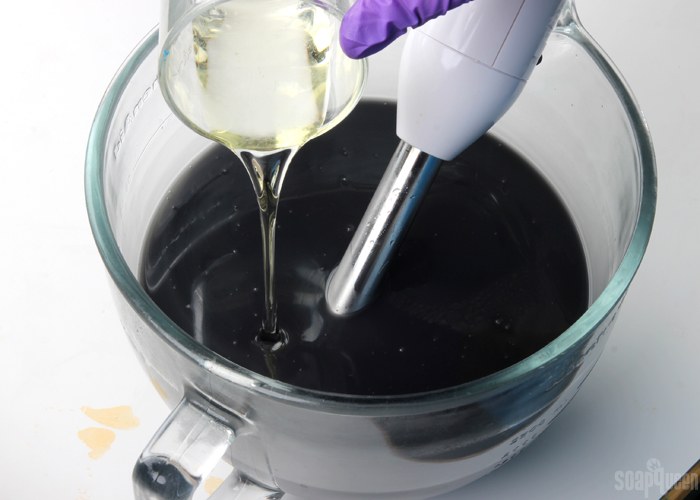 TEN: While the soap is still thin, very gently and carefully pour the soap into the mold. Don’t pour from too high above the mold, or this can cause the soap to “crush” the bottom layer which could ruin the shape. Continue to pour the soap into the mold until completely full. Pour any extra soap into a separate container.
TEN: While the soap is still thin, very gently and carefully pour the soap into the mold. Don’t pour from too high above the mold, or this can cause the soap to “crush” the bottom layer which could ruin the shape. Continue to pour the soap into the mold until completely full. Pour any extra soap into a separate container.
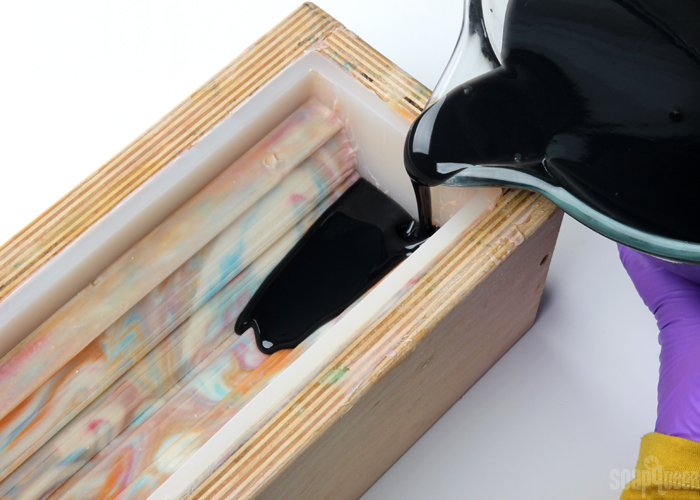 ELEVEN: Allow the black layer of soap to sit and harden for about 7-10 minutes. The exact time of your batch might vary, as the temperature of your soap will most likely be different, causing it to set up at a slightly different rate. Once the soap is firm enough to hold a shape, insert the small cardboard shape at one end, and slide it down the length of the mold. Place the “extra” soap into a separate mold. I had about 16 ounces of “discard” soap. Be careful to not let the cardboard shape “wiggle” too much as you drag it across, which will affect the shape of the horse image. Once all the “extra” black soap has been removed and the shape is nice and clean, it’s time for the third and final layer!
ELEVEN: Allow the black layer of soap to sit and harden for about 7-10 minutes. The exact time of your batch might vary, as the temperature of your soap will most likely be different, causing it to set up at a slightly different rate. Once the soap is firm enough to hold a shape, insert the small cardboard shape at one end, and slide it down the length of the mold. Place the “extra” soap into a separate mold. I had about 16 ounces of “discard” soap. Be careful to not let the cardboard shape “wiggle” too much as you drag it across, which will affect the shape of the horse image. Once all the “extra” black soap has been removed and the shape is nice and clean, it’s time for the third and final layer!
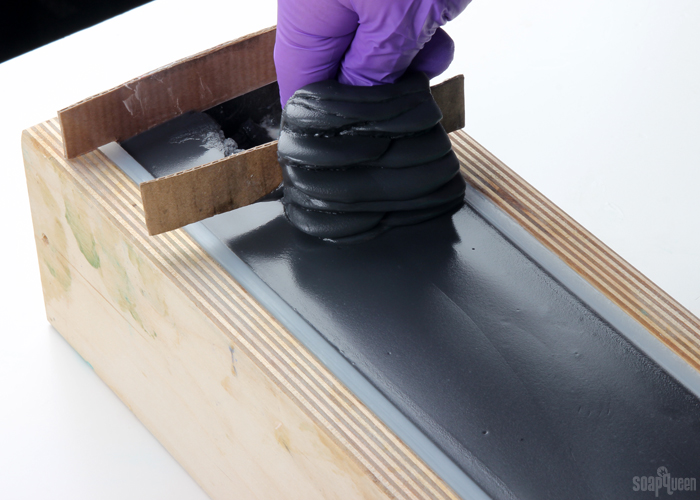
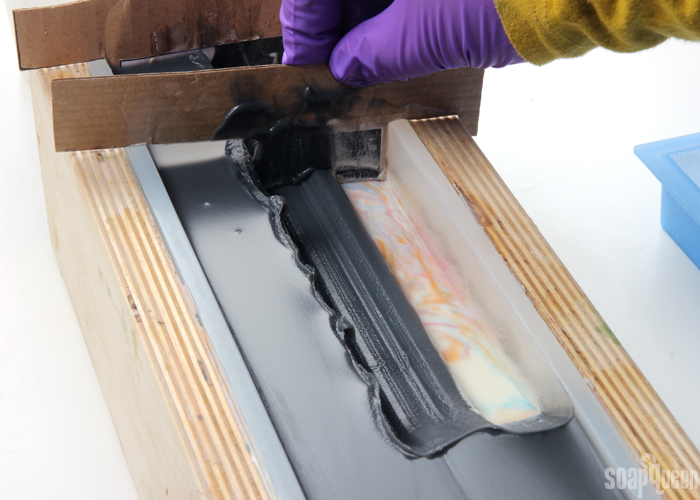 NOTE: As you can see below, I waited a teensy-tiny bit too long to pull the shaper through the mold. You can see how the top corner of the black soap didn’t pull away smoothly, but instead “tore” a bit. I used a spoon to smooth this out, and it ended up being okay. But this is actually what you want to avoid.
NOTE: As you can see below, I waited a teensy-tiny bit too long to pull the shaper through the mold. You can see how the top corner of the black soap didn’t pull away smoothly, but instead “tore” a bit. I used a spoon to smooth this out, and it ended up being okay. But this is actually what you want to avoid.
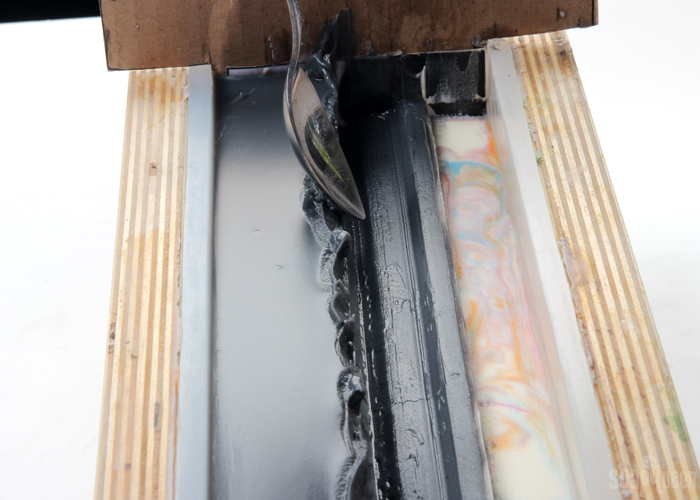 BATCH #3
BATCH #3
FRAGRANCE PREP: Measure 1 ounce of the Apple Sage Fragrance Oil into a glass, fragrance oil safe container, set aside.
TWELVE: Heat up the bowl of oils for batch three if necessary, to about 130 ° F. Most likely, the lye water will be a little on the cool side, but that’s okay. Add the batch three lye water to the oils and stick blend until thin trace.
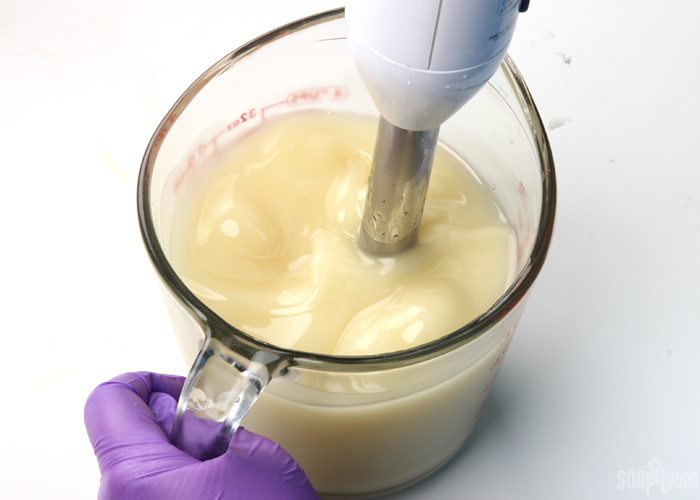 THIRTEEN: Once the soap is at a thin trace, add 1/2 Tbs. dispersed titanium dioxide into the entire batch. Split off three containers of soap at 100 mL each and add the following dispersed colorants below. Use a whisk to blend them in completely. Then, add the measured Apple Sage Fragrance Oil into the containers of soap proportionally, it’s okay to eyeball it. Use a whisk to mix in.
THIRTEEN: Once the soap is at a thin trace, add 1/2 Tbs. dispersed titanium dioxide into the entire batch. Split off three containers of soap at 100 mL each and add the following dispersed colorants below. Use a whisk to blend them in completely. Then, add the measured Apple Sage Fragrance Oil into the containers of soap proportionally, it’s okay to eyeball it. Use a whisk to mix in.
- Container A (100 mL): 1/2 tsp. dispersed Buttercup Mica
- Container B (100 mL): 1/4 tsp. dispersed Slushy Blue Mica
- Container C (100 mL): 1/4 tsp. Magenta Mica
FOURTEEN: Just like the first batch, pour the pink, blue, and yellow (it will look orange!) soap into the bowl of white soap. Pour from varying heights to allow the soap to break into various spots of the bowl. Once all the colors have been poured, use the dowel or chopstick to fully swirl the soap in a circular motion several times.
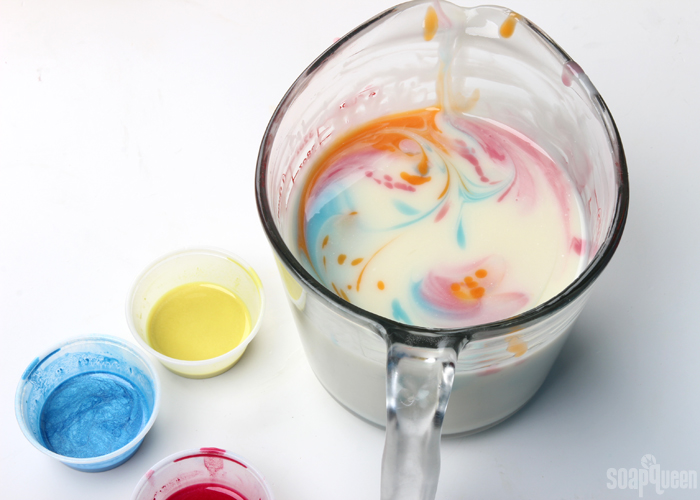 FIFTEEN: Carefully pour the soap into the mold, starting by filling “empty” area of the mold where the black soap was scraped out. Continue to fill the mold completely, covering the top of the black soap. Use the back of a small spoon to even out the top of the soap if necessary. Spritz the mold with 99% isopropyl alcohol, and allow to sit in the mold for about 2-3 days. I did not cover the soap, as it would have disrupted the top. If your soaping area is very cold, create a “cardboard tent” over the top to help insulate the soap for 24 hours.
FIFTEEN: Carefully pour the soap into the mold, starting by filling “empty” area of the mold where the black soap was scraped out. Continue to fill the mold completely, covering the top of the black soap. Use the back of a small spoon to even out the top of the soap if necessary. Spritz the mold with 99% isopropyl alcohol, and allow to sit in the mold for about 2-3 days. I did not cover the soap, as it would have disrupted the top. If your soaping area is very cold, create a “cardboard tent” over the top to help insulate the soap for 24 hours.
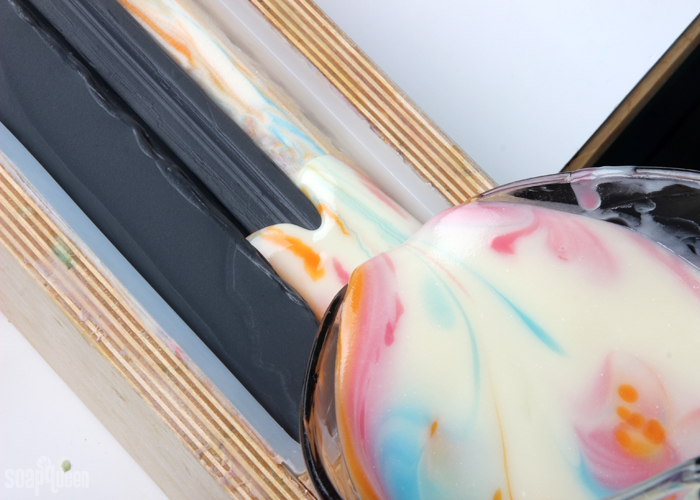
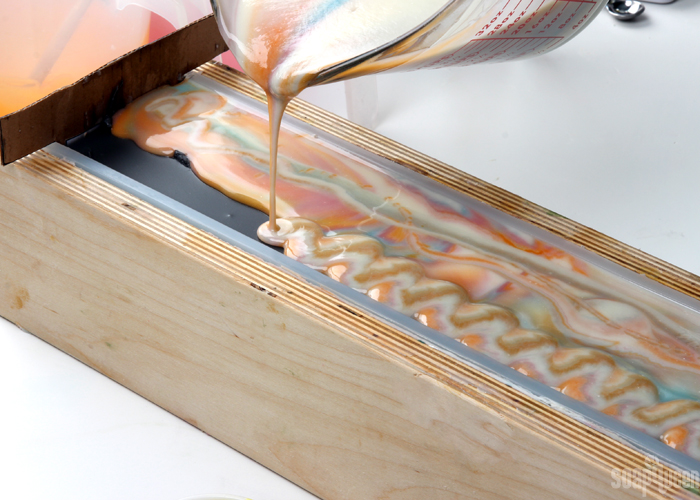
After about 2-3 days, carefully remove from the mold, and cut into bars. I found that some bars turned out a little bit better than others, and you can very faintly see the difference between the first multi-colored layer, and the last because the swirl is slightly different.
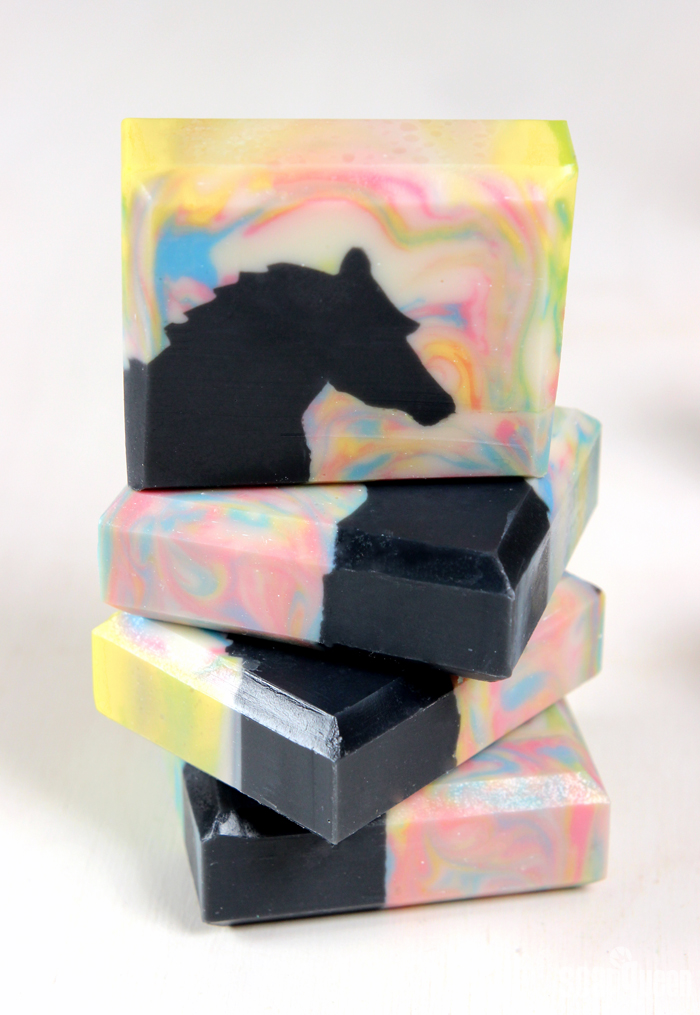
Click to View the Recipe
- 5 Pound Mold with Sliding Bottom
- Silicone Liner for 5 lb Wood Mold
- Horse Silhouette Template
- 40 oz. Basic Quick Mix
- 13.2 oz. Distilled Water
- 5.7 oz. Sodium Hydroxide Lye
- 2 oz. Apple Sage Fragrance Oil
- Titanium Dioxide
- Buttercup Mica
- Magenta Mica
- Blue Slushy Mica
- 40 oz. Basic Quick Mix
- 13.2 oz. Distilled Water
- 5.7 oz. Sodium Hydroxide Lye
- 2 oz. Apple Sage Fragrance Oil
- Black Oxide
- 20 oz. Basic Quick Mix
- 6.6 oz. Distilled Water
- 2.8 oz. Sodium Hydroxide Lye
- 1 oz. Apple Sage Fragrance Oil
- Titanium Dioxide
- Buttercup Mica
- Magenta Mica
- Blue Slushy Mica
The first piece I made was the entire horse image, which was placed on one end of the mold. I used this as a guide for pouring the soap into the mold to the appropriate heights (shown below). To make this piece, I cut the horse image and taped it to cardboard. Then, I cut the cardboard to include a lip on top to keep it in place.
The other two pieces were made in a similar way. Print the horse image on a piece of paper, cut the cardboard to fit inside the width of the inside of the mold, and cut. Then, wrap the whole thing in clear plastic tape. This prevents it from becoming soggy when it comes in contact with the soap batter. On the top lip, I included a small piece that hangs over the side of the mold (shown on the right in the image below). The way, when you slide the piece down the length of the mold, it will stay in the same place with each pass. This is an important part of this technique; each pass needs to go in the exact same place, or it will muddle the shape. For the first piece, cut around the top of the horse head, ending where the nose begins to curve. This will be used to create the first layer. The second piece needs to “complete” the first. Cut out the entire horse head, including the nose, leaving behind the spot under the nose. You can see what the two pieces should look like below. Set your pieces aside to prep the remaining ingredients.
- Slowly and carefully add the lye to the water for all three batches, and gently stir until the lye has fully dissolved and the liquid is clear. Set aside to cool. You will have three containers of lye, with the amounts below. Once cooled, add sodium lactate to the lye water for a bar of soap that releases faster from the mold.
-Batch One Lye Solution: 13.2 oz. Distilled Water + 5.7 oz. Sodium Hydroxide Lye + 2.5 tsp. Sodium Lactate (optional)
-Batch Two Lye Solution: 13.2 oz. Distilled Water + 5.7 oz. Sodium Hydroxide Lye + 2.5 tsp. Sodium Lactate (optional)
-Batch Three Lye Solution: 6.6 oz. Distilled Water + 2.8 oz. Sodium Hydroxide Lye + 1 tsp. Sodium Lactate (optional) - Fully melt the entire bag of Basic Quick Mix until there is no cloudiness. Give it a good shake to mix all the oils, and measure out 40 ounces into one soaping bowl, 40 ounces into a second and 20 ounces into a third. Set aside the bowls of oil for batch two and three. Once the lye water and the oils for batch one have cooled to 130 degrees or below (and are ideally within 10 degrees of each other), add the batch one lye water to the oils and stick blend until thin trace.
- Once you have a thin trace, add 1 Tbs. dispersed titanium dioxide into the entire batch. Split off three containers of 200 mL. Add the dispersed colorants in the following amounts below, and use a whisk to fully incorporate the colorants.
-Container A (200 mL): 1 tsp. dispersed Buttercup Mica
-Container B (200 mL): ½ tsp. dispersed Slushy Blue Mica
-Container C (200 mL): ½ tsp. Magenta Mica - Add the measured Apple Sage Fragrance Oil into each container proportionally, it’s okay to eyeball it. Use a whisk to mix in the fragrance oil. If the batter is still extremely thin, give the white soap a short burst or two with the stick blender to thicken slightly. The soap should be a thin-medium trace.
- Create an In-The-Pot Swirl by pouring the pink, yellow and blue soap into various areas of the white bowl of soap. Pour from various heights above the mold. This helps the colors break through the white, and reach the bottom of the bowl as well as the top. Once the colors have all been poured, use a chopstick or dowel to swirl the soap in a circular motion three to four times.
- Pour the soap into the mold. The soap will not fill up the mold all the way; fill up to the middle-ish of the horse nose. Give the mold a tap on the counter to help release air bubbles.
- Now, it’s time to wait for the soap to firm and harden. The soap should be firm enough to hold its shape, but thin enough for the soap to be scraped out smoothly. It’s a little hard to know when that “perfect” texture has been achieved. I tested every 3-5 minutes or so by scraping a small amount of the very top of the soap with a spoon. It is better to start scraping out the extra soap sooner rather than later. If the soap is not thick enough to hold any shape, let it harden for a few more minutes. But, if the soap is too thick, there is no going back. For this recipe, I found waiting about 8 minutes was the perfect amount of time for the first layer. Your soap may require more or less time, so keep an eye on it.
Once the soap is an appropriate texture, insert the cardboard shape with the horse nose into one edge of the soap, and begin pulling it through the mold. Place the extra soap into a separate mold if you’d like to save it. The first few passes with the cardboard shaper will be a little awkward and messy, but that’s okay! This process will begin to form the top of the horse’s outline including the mane, ears, and top of the nose.
Continue sliding the shaper through the mold. I recommend sliding it in both directions; it will help pull away every little bit of soap for the cleanest image. As you can see below, the shape of the horse is starting to come together! Once you pull the scraper away and it’s no longer pulling soap out, you know it’s done. Allow this layer to sit and harden for 10-15 minutes. The bottom layer should be firm enough to support a thin layer of soap on top without it squishing the small details of the mane, and general shape of the nose.
- Once the first layer is firm, it’s time to make the second layer. Heat up the bowl of oils for batch two if necessary to 120-130 ° F. Most likely, the lye water will be a little on the cool side, but that’s okay. Add the batch two lye water to the oils and stick blend until thin trace.
- Add 1 teaspoon dispersed Black Oxide, and the measured Apple Sage Fragrance Oil. Use a whisk to fully mix in the colorant and fragrance oil.
- While the soap is still thin, very gently and carefully pour the soap into the mold. Don’t pour from too high above the mold, or this can cause the soap to “crush” the bottom layer which could ruin the shape. Continue to pour the soap into the mold until completely full. Pour any extra soap into a separate container.
- Allow the black layer of soap to sit and harden for about 7-10 minutes. The exact time of your batch might vary, as the temperature of your soap will most likely be different, causing it to set up at a slightly different rate. Once the soap is firm enough to hold a shape, insert the small cardboard shape at one end, and slide it down the length of the mold. Place the “extra” soap into a separate mold. I had about 16 ounces of “discard” soap. Be careful to not let the cardboard shape “wiggle” too much as you drag it across, which will affect the shape of the horse image. Once all the “extra” black soap has been removed and the shape is nice and clean, it’s time for the third and final layer!
- Heat up the bowl of oils for batch three if necessary, to about 130 ° F. Most likely, the lye water will be a little on the cool side, but that’s okay. Add the batch three lye water to the oils and stick blend until thin trace.
- Once the soap is at a thin trace, add ½ Tbs. dispersed titanium dioxide into the entire batch. Split off three containers of soap at 100 mL each and add the following dispersed colorants below. Use a whisk to blend them in completely. Then, add the measured Apple Sage Fragrance Oil into the containers of soap proportionally, it’s okay to eyeball it. Use a whisk to mix in.
-Container A (100 mL): ½ tsp. dispersed Buttercup Mica
-Container B (100 mL): ¼ tsp. dispersed Slushy Blue Mica
-Container C (100 mL): ¼ tsp. Magenta Mica - Just like the first batch, pour the pink, blue, and yellow (it will look orange!) soap into the bowl of white soap. Pour from varying heights to allow the soap to break into various spots of the bowl. Once all the colors have been poured, use the dowel or chopstick to fully swirl the soap in a circular motion several times.
- Carefully pour the soap into the mold, starting by filling “empty” area of the mold where the black soap was scraped out. Continue to fill the mold completely, covering the top of the black soap. Use the back of a small spoon to even out the top of the soap if necessary. Spritz the mold with 99% isopropyl alcohol, and allow to sit in the mold for about 2-3 days. I did not cover the soap, as it would have disrupted the top. If your soaping area is very cold, create a “cardboard tent” over the top to help insulate the soap for 24 hours.
- After about 2-3 days, carefully remove from the mold, and cut into bars. I found that some bars turned out a little bit better than others, and you can very faintly see the difference between the first multi-colored layer, and the last because the swirl is slightly different.
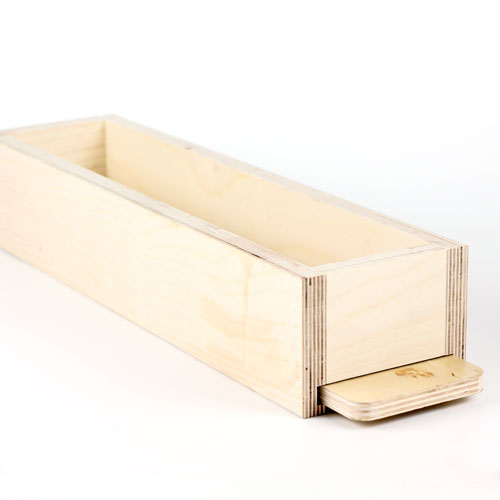

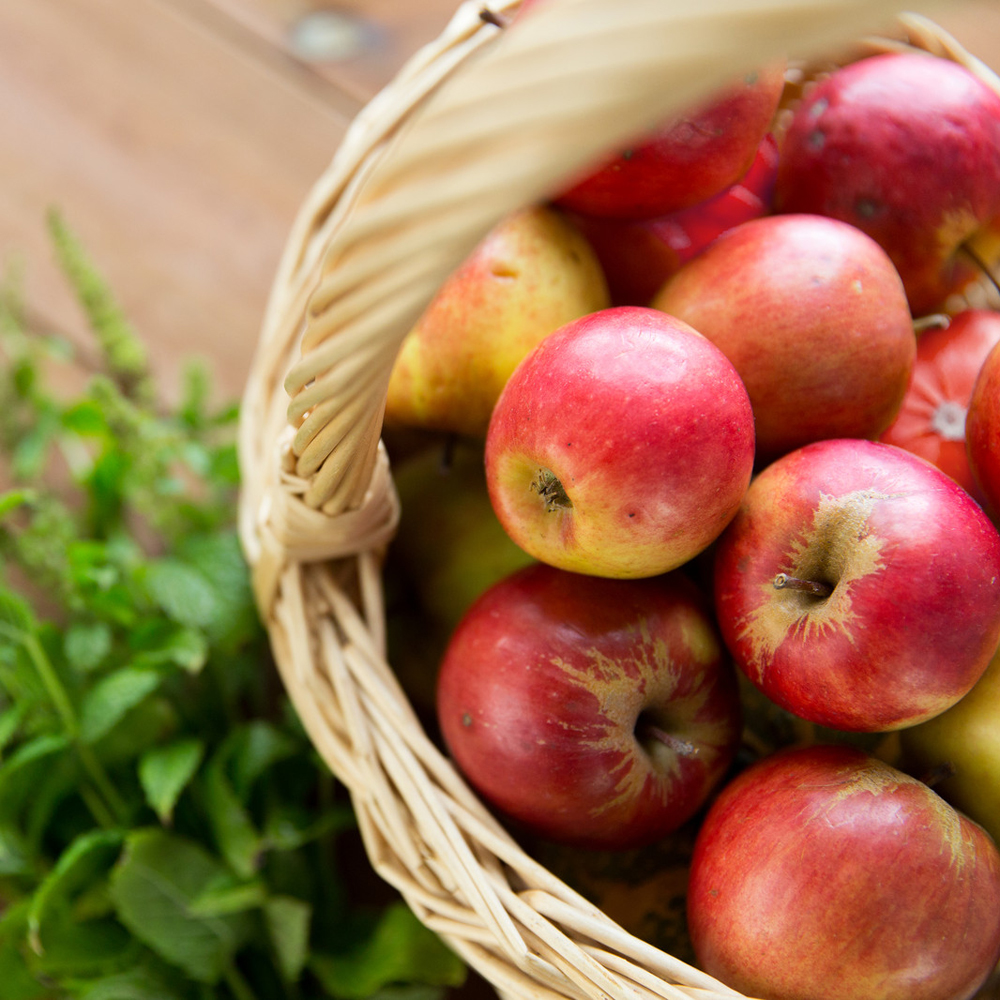

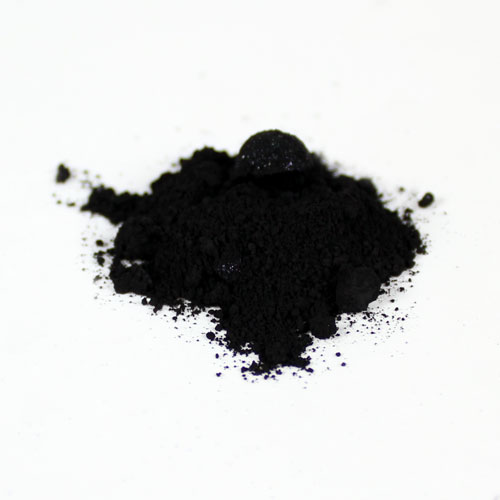
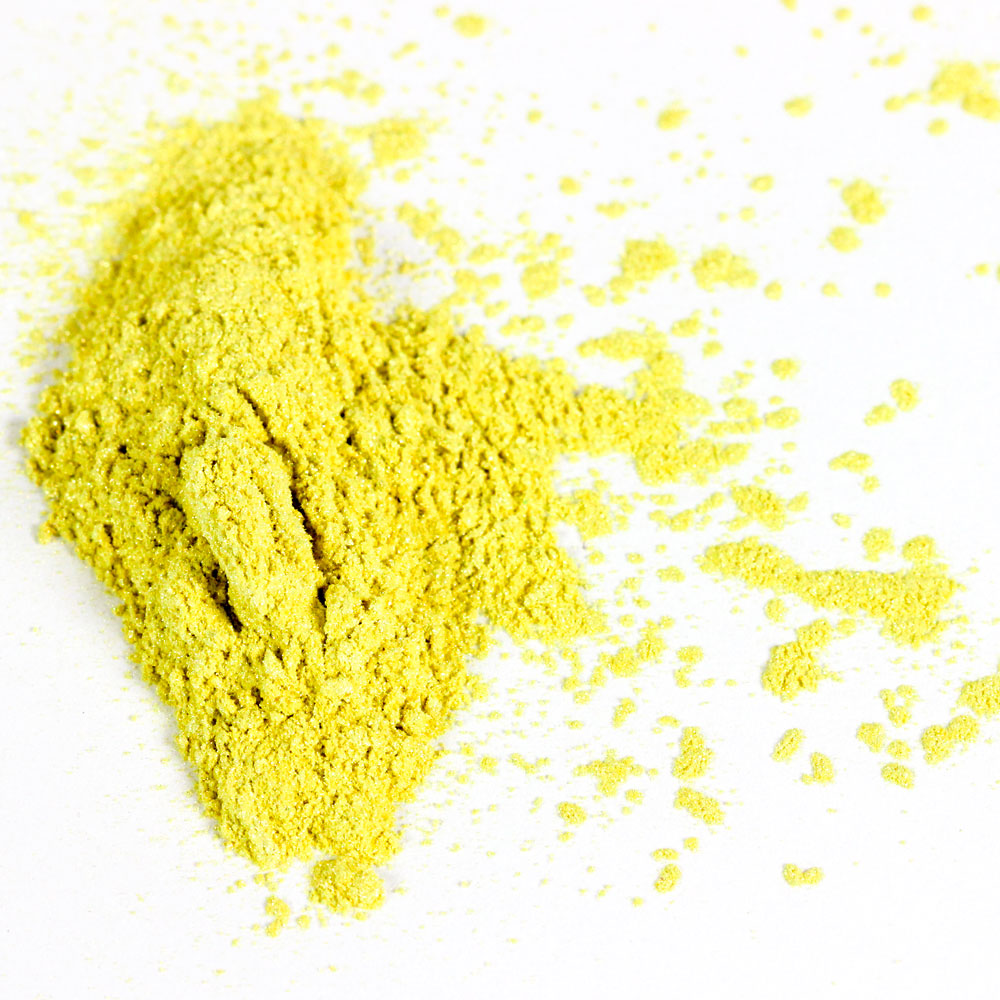
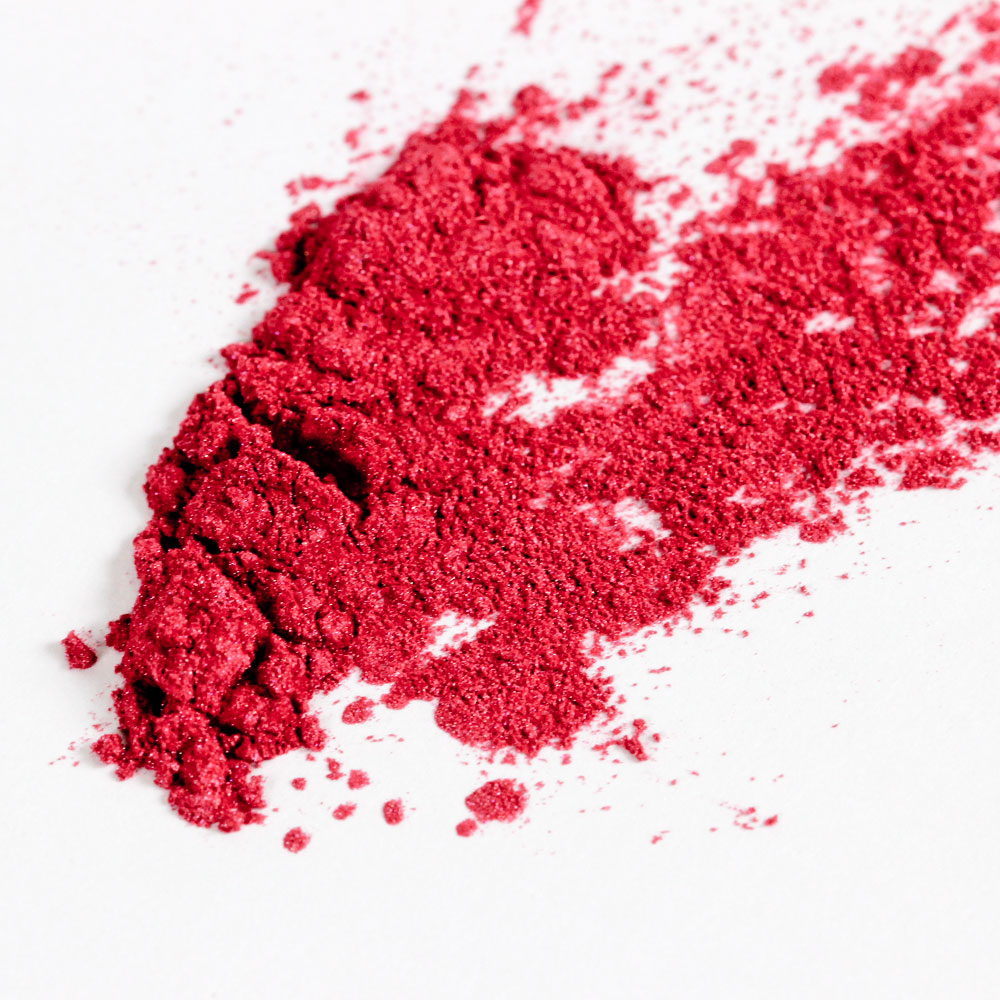
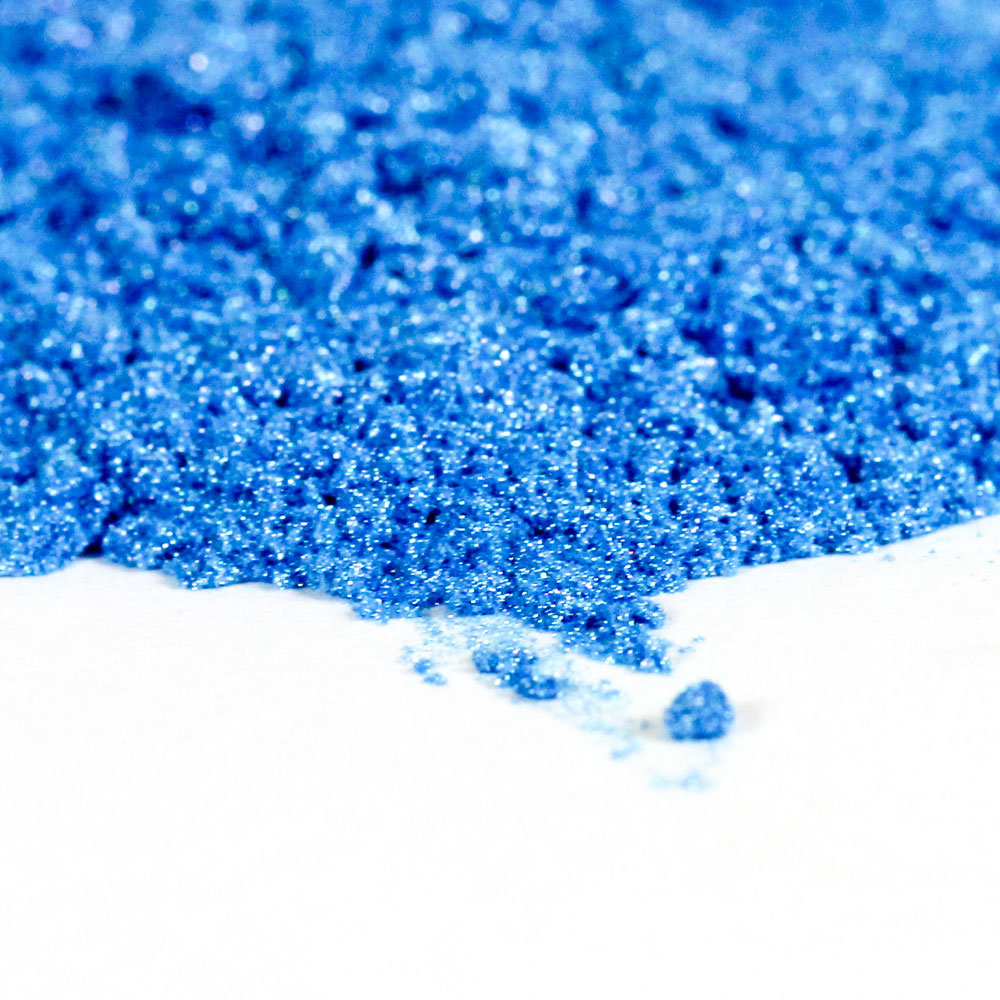
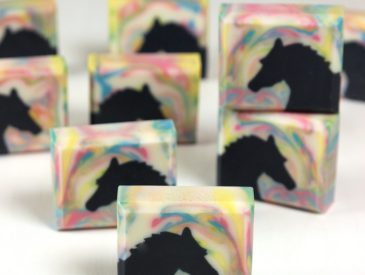


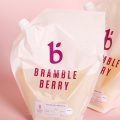
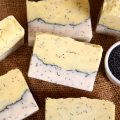
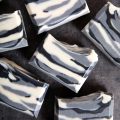
Can you use a melt and pour with this project?
You wouldn’t be able to get this look using the same method as above. Instead, you may try embedding. That would involve making a horse-shaped soap first, then putting it into another soap. Learn how to embed melt and pour here: https://www.youtube.com/watch?v=H_to0MjfFbo
As for the horse shape, you can make that with a horse shape and Flexy Fast Molding Putty: https://www.youtube.com/watch?v=ok00mvuKfvg
Im so new at soap making.It will take me a while before I can get the talent and courage up to make this soap. Due to your directions… I can see the technique is possible. I have to say that is soap designes at its finest. Supper advanced creativity, yet obtainable. Thank you for the step by step instructions. Sincerely Terrillynn.
Oh thank you so much Terrillynn, that means a lot to us. You’ll be making this recipe in no time. 🙂
-Kelsey with Bramble Berry
I’m so excited! I made it using 100% coconut oil and it looks like a horse! I modified with what I had for coloring. Horse colored with charcoal and just a plain white background colored with titanium dioxide. I could see a line where the two background layers meet but it’s minimum. I think the swirls would hide it better. I can’t wait to try other scenes!
That is so awesome Amy, glad to hear these bars turned out well! If you have a picture we’d love to see it on our Facebook page. 🙂
Bramble Berry Facebook page: https://www.facebook.com/BrambleBerry/
-Kelsey with Bramble Berry
I did it, I tried it! I also did the soap challenge, but couldn’t get my head wrapped around it and I didn’t have an entry. Having the printables helped so much! I must say having the soap set up was way too long for my recipe. Maybe using a more of an accelerator for the fragrance oil would help. Out of my 5 pound loaf I got 6 bars of a good horse, the others looked like sea horses. Actually one half of my batch wouldn’t set up as much as the other that turned out. I will definitely do this again. I didn’t mix my leftover soap and got some pretty nice bars. If someone could make the scrapers out of a heavy plastic, already to buy, would be fun, hint hint!
So glad you gave this soap a try Toni, and that you got some great bars out of it! Also, the plastic scrapers are a great idea. Our research and development department is looking into that. 🙂
-Kelsey with Bramble Berry
I am a beginner.Please let me know if take any classes online or if there are any video tutorials that I can enroll to?
If you’re in the Bellingham area, our retail store Otion offers classes! Find out more here: http://otionsoap.com/soap-making-classes/
We also have lots of free videos on our YouTube channel. They show you how to make soap, lotion, candles and more. 🙂
Soap Queen TV: https://www.youtube.com/user/soapqueentv
-Kelsey with Bramble Berry
This was nice for Claudia to share this technique with the soaping community. Thanks for featuring this on the blog. I can’t wait to give this technique a go!!!!
Absolutely, Claudia is so talented! Have fun giving this a try Tonya. 🙂
-Kelsey with Bramble Berry
What a clever technique. Bravo! And how kind of Claudia to share with us all. The generosity of the soaping community never ceases to amaze and impress me. I will be trying this too. Thanks for the excellent tutorial. Lovely soap! 🙂
So true,, I hope someday I can share/do something this beautiful.
Absolutely, I’m so glad Claudia shared her technique so we could give it a try! Thanks Heather and Debra. 🙂
-Kelsey with Bramble Berry
This looks so cool. I wish I had the skill to make something like this. Every time I come back to this site I always see another creation I had no idea you could make.
Oh thank you John! I hope you get a chance to try this design. It is a bit of a challenge but the results are worth it! 🙂
-Kelsey with Bramble Berry
AMAZING! I was just thinking the other day about wanting to make a shape through a bar of soap and decided it was impossible! Mind completely blown, I need to give this a try 🙂
Have fun giving this one a try Liz! It creates such cool bars. 🙂
-Kelsey with Bramble Berry
Can you show what the “throw-away” soap looks like. Thanks for sharing! Quite amazing, but a bit too fussy for me. Beautiful, though….in my next life when I don’t have a crazy job I’ll try all of these amazing techniques…lol for now I’ll just admire other people’s talent. You and your team are amazing!
We’ll see if we can get a picture of the excess soap posted! Thanks for your comment Andrea. 🙂
-Kelsey with Bramble Berry
Ditto what Andrea said! Once I retire from my WAY too stressful, busy job I’ll look forward to trying out all these challenging and creative techniques! Till then I guess I will just admire them in awe!!!
Sounds like a good plan to me! Thanks Vicki. 🙂
-Kelsey with Bramble Berry
I don’t get the second part, I would love to see a video of this.
Oh I’m sorry about that Jackie! What’s not making sense? I can try to clear things up for you. 🙂
-Kelsey with Bramble Berry
Some people’s talent and creativity are simply astounding. I’ve seen a few others do this but never had the courage to try it. Perhaps someday. Thanks for sharing your talent and creativity with the world.
You’re very welcome Eric, thanks for your kind comment! It means a lot to us. 🙂
-Kelsey with Bramble Berry
Wait. What? That’s how you do that? My mind is blown! What an amazing technique! Thanks for sharing.
You’re welcome Christine! Once we saw Claudia demonstrate it we just had to give it a try. 🙂
-Kelsey with Bramble Berry
Wow.. going to put it on my list to try it some day.. Awesome..
This is a really fun technique to try! 🙂
-Kelsey with Bramble Berry
Amazing! I was wondering how that technique worked, but was busy with a big move that month. Thanks for sharing the really clear pictures and description of the technique. You ended up with a gorgeous soap in lovely colors!
You’re very welcome Margaret, thank you for your sweet comment! Hope your move went smoothly. 🙂
-Kelsey with Bramble Berry
so awesome
Thank you so much Estelle! 🙂
-Kelsey with Bramble Berry